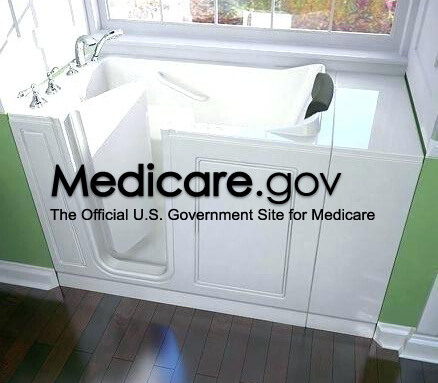As a general rule, Medicare doesn’t cover walk-in tubs but could be eligible for reimbursement with a doctor’s prescription demonstrating medical necessity.
However, Medicare does not classify a walk-in tub as Durable Medical Equipment (DME) under Medicare Part B, but some people with limitations or older can obtain a doctor’s prescription and make a claim for it.

Does Medicare cover walk-in tubs?
According to Original Medicare, Part A (hospital insurance) and Part B (medical insurance) typically do not cover the cost of walk-in tubs.
Since these tubs are considered home modifications rather than medical devices, they fall outside the scope of Medicare’s coverage.
Medicare Part C, known as Medicare Advantage, is a privately offered alternative to Original Medicare. It may cover walk-in tubs if they are deemed medically necessary.
To qualify, your doctor must prescribe the walk-in tub and demonstrate that it is essential for improving your health or preventing further illness.
A plethora of different medical items belong to the group which is considered durable equipment.
Medicare program usually reimbursement for the following items:
- Special chairs
- Patient lift
- Adjustable bed (hospital-style)
- Special commodes
In fact, all these pieces are in place so that seniors can use a walk-in tub shower easily and safely.

Medicare is designed to assist individuals with lower incomes and those who face obstacles in accessing healthcare.
Certain medical conditions, undocumented immigrants, and blind or disabled individuals may not qualify for coverage through private insurance markets in their states. Depending on their financial circumstances and the specific resources available in their state, they might consider enrolling in Medicare.
We’ll explain the steps to get the coverage you need.
Coverage through a Medicare Advantage plan
Medicare can cover walk-in tubs if you provide a medical diagnosis detailing the beneficiary’s need and the medical reasons for the necessity.
You will never receive an upfront payment, but you may be reimbursed.
Before 2018, Medicare did not cover surgical supplies for men or women aged 55 and older. Now, it does.
In general, one has to try it to benefit from using a walk-in tub, which is durable medical equipment. In this regard, a medical diagnosis will substantiate the needs of the enthusiastic beneficiary.
A medical report showing a diagnosis or a prescription written by a registered physician may serve the purpose well.
The doctor must pass you a letter of medical necessity for the walk-in tub.
The prescription or diagnostic report should outline authentic reasons for getting a walk-in tub.
Gathering all the above supportive documents does not necessarily mean that Medicare guarantees its assistance.
It can be best to take the walk-in tub as an out-of-pocket possession, which means that people should look for other sources of financial assistance.
People should prefer to prepare to bear the cost personally after submitting a claim and getting approved to wait for the best support.
The only thing that can be said is that support is unavailable before purchasing such tubs.
Rather, the support is provided in the form of pay, yet these excellent tubs would be considered a medical necessity. Well, it is simply a modification of the home that Medicare is not willing to cover. Such installation does not mean any addition but an absolute modification at a certain place in the home.
Getting Medicare Reimbursement
You may make a compelling presentation for your Medicare claim by using the suggested approach below:
1 – Prescription by your doctor
You need a prescription from your doctor demonstrating the necessity of the walk-in tub. Depending on what your doctor decides to write, it might discuss your medical condition, how it improves your living circumstances, the tub’s advantages, how it treats your conditions, or something else entirely.
2 – Purchase the walk-in tub of your choice
To submit claims, you must be registered in Medicare Part B (Medical Insurance). Download the instructions and Form CMS-1490S (included in the booklet).
3 – Save a copy of the product specification sheet
The company cannot file the claim for you because walk-in tubs are not yet officially designated DMEs… You must file it on your own.
As a result, unless you include the following statement, Medicare will reject your claim:
“The supplier did not refuse to file a Medicare claim or enroll in Medicare.” Because this claim is for a walk-in tub not currently listed as ‘Durable Medical Equipment,’ the supplier cannot file the claim, so I am filing it.”
Please include a copy of the Claim Filing Statement with your claim.
4 – Claim Filing Declaration
Put together your initial claim, which should include:
Doctor’s Prescription Form CMS-1490S…
Doctor’s Letter of Recommendation, originally attached to the back of Form CMS-1490S
Model Specification Sheet Tub
Invoice and Claim Filing Statement with Proof of Payment
Anything else you think might help your case
5 – Send your original Claim through the mail.
Your claim should be stapled together to prevent loss.
Keep everything flat and put everything in a 9″ x 12″ envelope.
Inscribe your return address on the package.
Put the relevant Medicare address for your state on the envelope using the Address Table in this booklet.
Include enough stamps and mail.
This is the complete process by which Medicare will review your case; it does not guarantee that you will receive a reimbursement.
Do everything calmly and as clearly as possible so that Medicare understands everything.
Coverage for Installation Costs
Medicare typically only reimburses the full purchase price of the walk-in tub, excluding installation costs. The installation cost, which ranges from $1,000 to $3,000, is usually not covered. The price of a walk-in tub ranges between $2,500 and $25,000.
It’s very rare that they pay the installation costs and other home modifications you may need to fit your walk-in tub in your bathroom, like accessibility modifications.
For those with balance or mobility issues, stepping over the edge of a high bathtub into hot water can be difficult without risking injury. Tubs come equipped with safety features, such as seats, that allow users to take advantage of all their benefits while keeping themselves safe.
Financial Assistance for Walk-In Tubs
Medicaid
If you meet the eligibility requirements for Medicaid, your state’s program may provide financial assistance for purchasing a walk-in bathtub.
Veterans Assistance
Veterans Assistance may support the acquisition of a walk-in tub, but this typically comes as a grant rather than VA insurance coverage. If you’re a veteran enrolled in TRICARE or CHAMPVA insurance schemes, obtaining financial assistance for a walk-in tub may be challenging. However, home modification grants for veterans requiring a walk-in bathtub are feasible.
Not all these grants are linked to military service, so veterans needing medical devices due to age-related needs could secure financial help. Remembering this isn’t a universal rule, so before purchasing a walk-in tub, ensure you qualify for the grant.
Private insurance
Some private insurance plans may include coverage for walk-in tubs. Review the terms and conditions of your policy or contact your insurance provider to ascertain if this benefit is available to you.
Financial assistance programs
Numerous financial assistance programs are available to help individuals pay for walk-in tubs. These programs are frequently funded by state or local governments and charitable organizations. Exploring these programs could help alleviate the financial burden of acquiring a walk-in tub.
It is crucial to thoroughly research and explore all available options to determine the most suitable and cost-effective way to obtain a walk-in tub that meets your needs.
Agriculture department grant
USDA Rural Development provides a grant to assist low-income seniors who own homes in carrying out home improvements and repairs. This grant could potentially cover the installation of a walk-in bathtub.
Tax deduction
Medicare is a federal health insurance program administered by the U.S. Department of Health and Human Services (HHS). One of the most important brands of walk-in tubs like American Standard starts at $4,000 up to $12,000.
If you are a disabled veteran, please check out this article.
Sources
- CMS finalizes Medicare Advantage and Part D payment and policy updates to maximize competition and coverage. (2019).
https://www.cms.gov/newsroom/press-releases/cms-finalizes-medicare-advantage-and-part-d-payment-and-policy-updates-maximize-competition-and - Durable medical equipment (DME) coverage. (n.d.).
https://www.medicare.gov/coverage/durable-medical-equipment-dme-coverage - Single-family housing repair loans and grants. (n.d.).
https://www.rd.usda.gov/programs-services/single-family-housing-repair-loans-grants - What does Part B of Medicare (medical insurance) cover? (2014).
https://www.hhs.gov/answers/medicare-and-medicaid/what-does-medicare-part-b-cover/index.html - What is Medicare Part A? (2014).
https://www.hhs.gov/answers/medicare-and-medicaid/what-is-medicare-part-a./index.html


